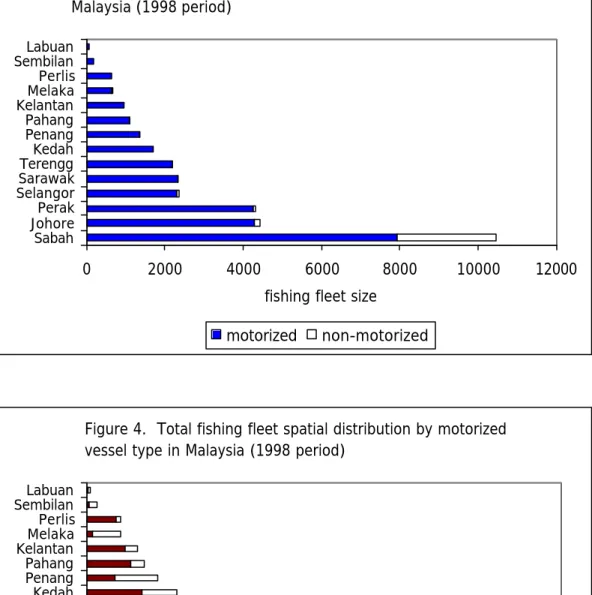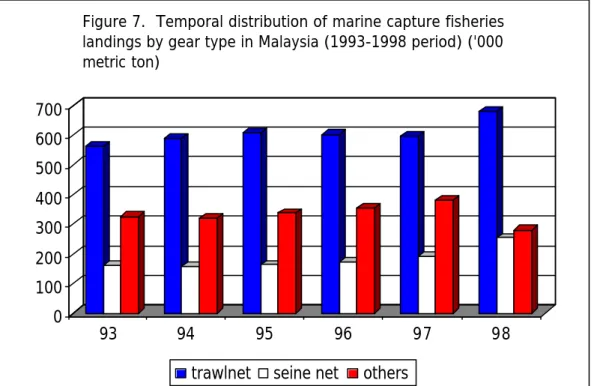There are 20,845 full-time fishermen in Sabah, representing 26% of the total fishermen population in the country (81,547). There are 15,120 fishermen in the SSME area (73% state total), representing 19% of the country total respectively. In the SSME area, there are 9,373 commercial fishermen or 73.5% of the total commercial fishermen in the state.
Commercial fishermen make up 62% of the total fishing population in the SSME area – with 44% of them involved in trawling. The above species formed the backbone of the pelagic fishery in Sabah, especially in the SSME-3 area.
INTRODUCTION
The most productive part of the Sulawesi Sea lies mostly in the shallow coastal areas (within the 200 meter depth) on the northeastern part of Kalimantan, which is shared between Indonesia and Malaysia (SSME3). The Malaysian portion of the SSME in the Sulawesi Sea is the main fishing ground for both demersal and pelagic fish, including reef fish in the state of Sabah. The Malaysian portion of the SSME occupies 56% of the highly productive coastal zone (within the 0-200 meter depth of the shelf area) in the state of Sabah.
A study conducted by Universiti Malaysia Sarawak recently showed that 90 percent of the state's 129 coral reefs had been damaged by fish bombing. 34;We believe this is only the tip of the iceberg.” He said the state's fishing industry was valued at RM40 million annually.
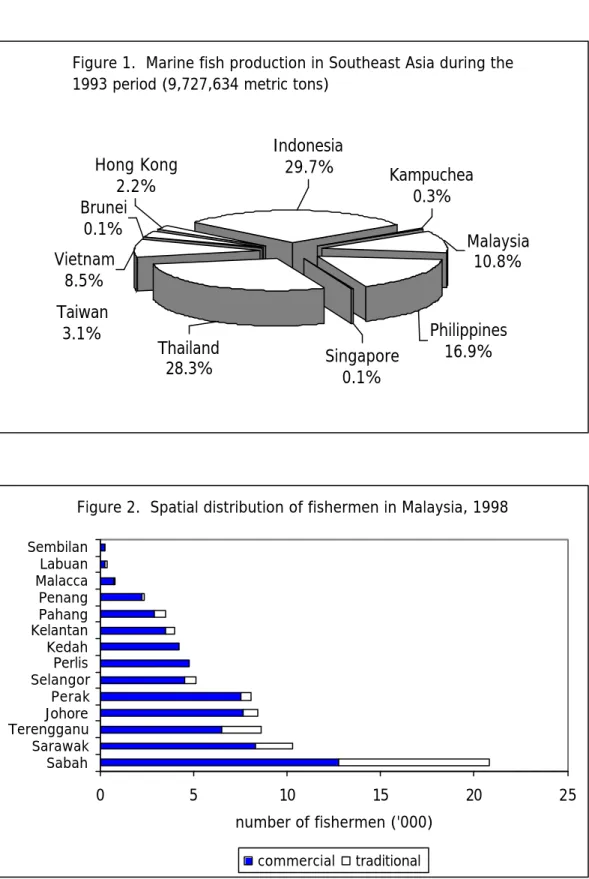
OVERVIEW OF THE FISHERIES INDUSTRY IN MALAYSIA
Trawlers landed a total of 681,223 metric tons in 1998, representing about 56% of the total combined gear landings in the country. Hoists (mobile and static types) landed a total of 22,230 metric tons in 1998, representing about 1.8% of the total combined gear landings in the country. Purse seines landed a total of 21,184 metric tons in 1998, representing about 1.8% of the total combined gear landings in the country.
Traps landed a total of 14,741 tons in 1998, representing approximately 1.2% of the country's total combined fishing gear landings. Shellfish collectors landed a total of 5,397 tons in 1998, representing 0.4% of the country's total fishing gear landings.

OVERVIEW OF THE STATE OF SABAH, MALAYSIA
The management of fisheries in Sabah falls under the purview of the Department of Fisheries Sabah (DOF Sabah), a department under the Ministry of Agriculture and Food Industry of the state government of Sabah. 36 The length of Sabah's coastline has historically been generally (and officially?) reported to be greater than 1600 km. The southwest monsoon transition period begins in September, with the weakening of Australian high pressure as the ITCZ is located at the equator and moves southward.
Coastal districts make up 78% of the administrative total land area – of which only 22% are inland. The mainland coastal zone is unevenly distributed: only 15% on the west coast and 85% on the east coast. The limited extent of the coastal zone on the west coast is due to the fact that the Crocker Range extends close to the coastline for most of its length.
Most of the islands are also in the SSME area, with 97% and 91% of the state island area and coastline in the SSME area, respectively. According to the Monthly Statistical Bulletin Sabah (July 2000 edition)42 non-Malaysians including illegal immigrants make up 29% of the total population. Fisheries are responsible for a small but important contribution to the State economy, accounting for 7% of the agricultural GDP or 2% of the State's annual GDP (Figure 36).
In terms of employment, the agricultural sector has the largest workforce, with 32% of the country's total in 1999 (Table A29). Most of the agricultural plantations in Sabah are located in the SSME area – SSME-1 (Oil Palm and Dill), SSME-2 (Oil Palm) and SSME (Oil Palm and Cocoa). The recently completed Sabah Integrated Coastal Zone Management (ICZM) study recommended several strategies related to coastal zone management in Sabah46.
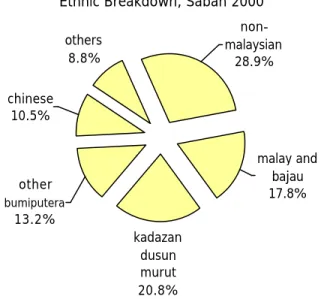
PROFILE OF THE FISHING DISTRICTS IN SABAH
The coastal waters of the SSME area represent approximately 53% of the state's total coastal waters (51,360 km2). The coastal zone of the SSME-1 area represents 12% of the coastal zone in the state. Kudat is a predominantly coastal district, with more than 97% of the total land area (including islands) in the coastal zone.
The coastal area of SSME-2 zone represents 61% of the coastal area in the state. SSME-2 is primarily a coastal zone, with 54% of the total land area (including islands) within the coastal zone. Coastal fisheries in SSME-2 contribute a significant portion of the total fishery production in the SSME area and in Sabah as a whole.
The coastal zone of the SSME-2 area represents 28% of the coastal zone of the country. An important part of the population consisted of illegal immigrants, mainly from Indonesia (Tawau) and the Philippines (Lahad Datu and Semporna). The cocoa processing plant in Tawau is one of the largest in the country.
The coastal fisheries in SSME-3 contribute the largest share of the total fishery production in the SSME area and in Sabah as a whole. Numerous small rocky islets along the coast make up only 0.4% (4 km2) of the total land area. The non-SSME area is predominantly a non-coastal zone, with 33% of the total land area within the coastal zone.
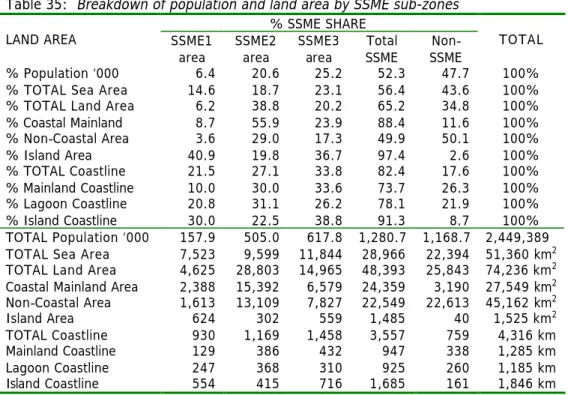
OVERVIEW OF THE FISHERIES INDUSTRY IN SABAH
The majority of the fishing grounds in Sabah are in the South China Sea, which extends to the edge of the continental shelf off the west coast. In general, most of the fishing activities in Sabah are concentrated in coastal waters within the 30 nautical mile zone that sustain both traditional and commercial fishing sectors. 115 Most of the commercial trawlers based in Kota Kinabalu are not capable of trawling beyond 80 meters depth.
Some of the resources have already shown signs of overfishing, especially for shrimp resources (Figure 39). The benthic assemblage in Sabah is typical of benthic faunal communities on predominantly soft substrates and coral reefs of the Indo Pacific region. Other seasonal species may appear from time to time depending on the time of year.
As a result of the damage, fish no longer breed in the reefs, Oakley says, and local fishermen's income has decreased. Using a hydrophone and tape recorder, Oakley has collected evidence of the damage to coral reef systems. Most of the fishing fleet consisted of small trawlers (10-25 GRT size) powered by 30-55 HP inboard engines.
Large trawlers were introduced targeting both shrimp and high-value small fish in the deeper waters of the coastal zone. Currently, the fishing fleet consisted of 1,442 trawlers of various sizes (Table A34) with fishing operations within 80 meters of the coastal zone. Temporal trends of CPUE (catch per unit effort) of Sabah shrimp trawl fishery.
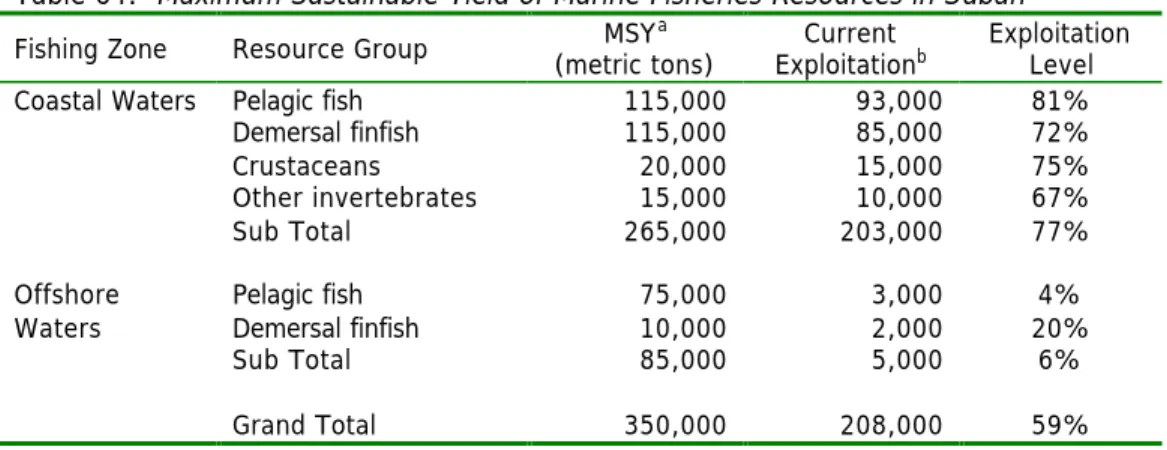
Distribution of fishermen involved by gear type in non-SSME - West Coast North, Sabah fishermen). Distribution of fishermen involved by gear type in non-SSME - west coast south, Sabah fishermen). In the SSME area, there are 5,747 traditional fishermen or 71% of the total traditional fishing population in the state.
In the SSME area, there are 9,373 commercial fishermen or 73.5% of the total commercial fishermen population in the state. There are 3,394 transient fishermen involved in commercial fishing, representing 59% of the total transient fishing population (5,767) in the state. Districts in the SSME area with most of the traditional fishermen involved in hook and line fishing include Pitas (59%) and Lahad Datu (73%).
In the non-SSME area, districts with high involvement of traditional fishermen in hook and line fishing include Sipitang (99%), Kota Kinabalu (76%), Kuala Penyu (71%), Kota Belud (69%) and Papar ( 62). %) with the exception of Tuaran (65% involved in selambau or seine net fishing) and Beaufort (83% involved in mangrove crab trapping). About 71% of the 1,869 fishermen involved in the operation of various traditional gear are located in the SSME area. Boat fishermen constituted the majority of the commercial fishing population in Sandakan (69%) and Tawau (54%) districts.
Overall, population growth in the SSME area is almost 2 times (39%) compared to the non-SSME area (20%). This significant change is due to a 325% increase in the number of fishermen engaged in hook &. The distribution of fishing gear by district in non-SMEs is given in table 96.
Spatial distribution of commercial fishing gear in the non-NSME area in Sabah gear units). Spatial distribution of traditional fishing gear in non-NSME area in Sabah gear units).
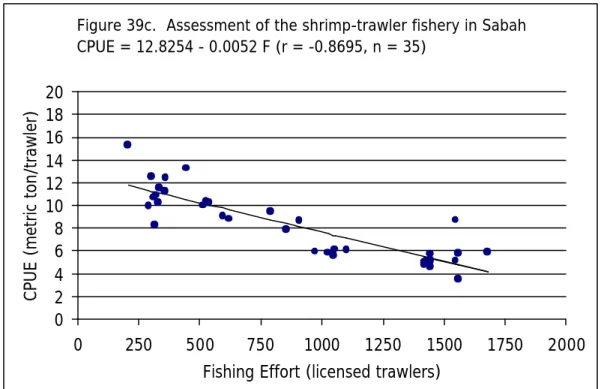
SSME1 SSME2 SSME3
Overall, the non-NSME area had contributed less than 35% to the annual declines in Sabah. The contribution of fishing gear to annual landings during the period 1991-1999 is summarized in Table 104. The contribution of non-NSME and NSME to annual landings in Sabah for the period 1991-1999 is summarized in Tables 105-106.
During 1991–1999, traditional gear landings accounted for the majority of annual landings in Tuaran, Kota Belud, Lahad Datu and Pitas (Figures 111–112). In the remaining areas, commercial gear landings account for more than 50% of annual landings. Non-SSME and SSME areas contributed 35% and 65% respectively to the annual traditional gear landing.
In the period 1991-1999, non-SSME and SSME areas contributed 24% and 76%, respectively, to the annual landings of various gear (Figure 246). SSME's contribution to the annual landing of various tools decreased by 23% over the 9-year period, from 84%. Overall, demersal fish accounted for 52% of Sabah's annual marine fish landings during 1991-1999.
During the same period, the non-SSME area contributed 33% to annual commercial gear landings (Figures 144-146). On the other hand, traditional gear contributed between 5-17% (average 12%) to the annual landings in Kota Kinabalu. Overall, Kota Kinabalu contributed 87% and 30% respectively to the annual landings of commercial and traditional gear in the non-SSME area.


